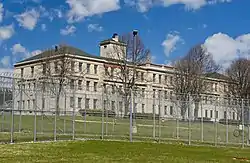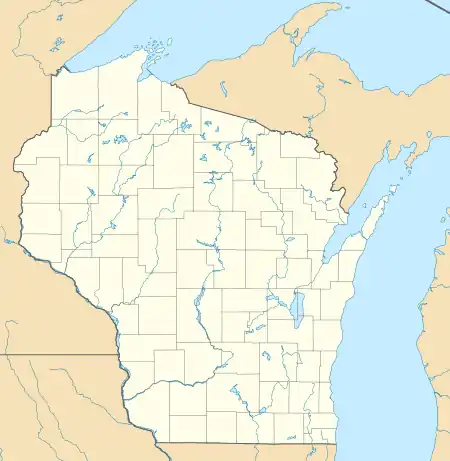Ethan Allen School for Boys
Ethan Allen School for Boys was a reform school in Delafield, Wisconsin (although the mailing address was in Wales, Wisconsin) which operated in a former tuberculosis sanitorium from April 1959 until June 2011, when it was abolished and the inmates moved to Lincoln Hills School in Irma.[2][3] It was operated by the Wisconsin Department of Corrections.
Statesan Historic District | |
 | |
  | |
| Location | Boys School Road, Wales |
|---|---|
| Built | 1907 |
| Architectural style | Craftsman |
| NRHP reference No. | 88000454[1] |
| Added to NRHP | April 21, 1988 |
The school campus was listed on the National Register of Historic Places in 1988 as the Statesan Historic District,[1] notable for being the first state-sponsored tuberculosis sanitorium in Wisconsin, and the largest.[4]
History
Human tuberculosis has been around since antiquity. Early treatments for the disease included patent medicines and tapeworms. TB sanitoriums were established in the US starting in 1875, usually focusing on fresh air, good diet, and bed rest. When the German Dr. Robert Koch identified the tuberculosis bacterium in 1882, doctors began to understand how it was transmitted, understanding that it was infectious. Yet with urbanization deaths from TB increased, and by 1900 it was the leading cause of death in Wisconsin, taking about 2,500 people each year. [4]
In 1905 the Wisconsin legislature approved building a sanitorium to treat pulmonary tuberculosis. The state purchased 200 acres on the south side of Government Hill, a sunny site with fresh air, and protection from north and east winds. By 1907 the Wisconsin State Sanitarium Hospital (Statesan) admitted its first 40 patients. An administration building had been built, a dining hall, a power plant, and several cottages for patients. The health of a patient determined the cottage, so as a patient improved, he/she moved to more healthy cottages.[4]
The initial complex in 1907 consisted of a 1.5-story Craftsman-styled dining hall, with a corner pavilion with large windows,[5] the laundry building,[6] the 2.5-story administration building,[7] and men's and women's cottages - long hip-roofed buildings with full-length porches on their south sides so patients could enjoy the sun and fresh air. Most of these buildings had walls of hollow clay tile, clad in stucco.[4]
The facility immediately filled up, so the next year the state added two more patient cottages. There were 87 patients in 1910, 175 by 1912. More cottages were added, and tents. In 1913 an assembly hall/chapel was added, two stories in a style similar to the other buildings.[8] In 1918 an infirmary was added.[4]
By 1929 the thinking on treating tuberculosis was changing. The previous approach had been largely passive: good food, good rest, and fresh air. By this time, surgical treatments were known, including pumping air between the lung and chest cavity to partially collapse the lung, and removing ribs to reduce lung activity. Coinciding with these new ideas, the facility built a large three-story 105-bed hospital.[9] No longer needed, the cottages were probably torn down at this time.[4]
The Statesan facility was the first in the state, but other state TB sanitariums soon followed. Lake Tomahawk Camp opened in Oneida County in 1915, as a destination for male patients who had completed treatment at Statesan. Other smaller county sanatoria began to open starting in 1913.[4]
Antibiotics like streptomycin were a powerful treatment for TB, reducing average length of stay at Statesan and increasing vacancies. By 1957 occupancy was about 50% and the state legislature decided to close the facility.[4]
In 1959 it reopened as a state reformatory for delinquent boys, the Ethan Allen School for Boys.[4]
References
- "National Register Information System". National Register of Historic Places. National Park Service. July 9, 2010.
- Trevota, Joe. "No more juveniles at Ethan Allen School: Corrections facility officially closes tomorrow" Living Lake County June 29, 2011
- "Ethan Allen School." Wisconsin Department of Corrections. Retrieved on July 5, 2010.
- James Draeger; William Wright (1987-10-10). NRHP Inventory/Nomination: Statesan Historic District. National Park Service. Retrieved 2019-10-20. With twelve photos.
- "State Tuberculosis Sanatorium". Wisconsin Historical Society. Retrieved 2019-10-20.
- "State Tuberculosis Sanatorium Laundry". Wisconsin Historical Society. Retrieved 2019-10-20.
- "Wisconsin School for Boys - Administration". Wisconsin Historical Society. Retrieved 2019-10-20.
- "State Tuberculosis Sanatorium - chapel". Wisconsin Historical Society. Retrieved 2019-10-20.
- "State Tuberculosis Sanatorium". Wisconsin Historical Society. Retrieved 2019-10-20.